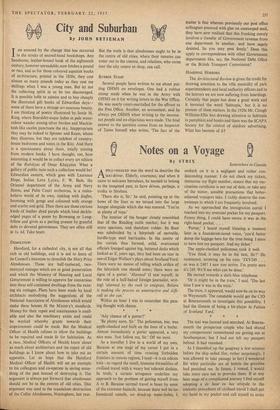City and Suburban
By JOHN BETJEMAN
AM amazed by the change that has occurred
I
in the stocks of second-hand bookshops. Any handsome, leather-bound book of the eighteenth century, however unreadable, now fetches a pound or two, and as for those coloured aquatint books of architecture, printed in the 1820s, they cost almost as many pounds today as they cost me shillings when I was a young man. But let not the collecting spirit in us be too discouraged. It is possible bdth to admire and to buy cheaply the illustrated gift books of Edwardian days— some of them have a strange art-nouveau beauty. I am thinking of poetry illustrated by Jessie M. King, where Beardsley-esque ladies in pale water- colour wander among silver birches and Mackin- tosh-like castles punctuate the sky. Inappropriate they may be indeed to Spenser and Keats, whom they illustrate, but they are redolent of country- house bedrooms and suites in the Ritz. And there is a spaciousness about them, totally missing from modern books. I have thought, too, how interesting it would be to collect every art edition of the Rubaiyat of Omar Khayyam. What a gallery of public taste such a collection would bet Edwardian eastern, which goes with Laurence Hope, Indian Love Lyrics, F. W. Bain, the Oriental department of the Army and Navy Stores, and Palm Court orchestras, is a make- believe world of its own, tinkling with jingles, booming with gongs and coloured with orange and scarlet and gold. Then there are those curious kinds of leather dyed purple which bind deckle- edged pages of a poem by Browning or Long- fellow and given as a parting present by grateful debs to devoted governesses. They are often still at Is. 6d. Take heart.
DEMOLITION
Hereford, for a cathedral city, is not all that rich in old buildings, and it is sad to learn of its Council's intention to demolish the Mary Price Almshouses. These are half-timbered, two- storeyed cottages which are in good preservation and which the Ministry of Housing and Local Government is willing to approve for conversion into three self-contained dwellings from the exist- ing six cottages. Plans have been made by local architects embodying the suggestions of the National Association of Almshouses which would make these houses fit the Ministry's standards. Money for their repair and maintenance is avail- able and also the machinery exists and could be worked whereby grants towards their improvement could be made. But the Medical Officer of Health refuses to allow the buildings to be repaired and made fit for habitation. As a race, Medical Officers of Health know about as much about architecture and the repair of old buildings as I know about how to take out an appendix. Let us hope that the Hereford Medical Officer of Health will set an example to his colleagues and co-operate in saving some- thing of the past instead of destroying it. The argument is always put forward that almshouseS should not be in the centres of old cities. This argument was used in the scandalous destruction of the Collin Almshouses, Nottingham, last year. But the truth is that almshouses ought to be in the centre of old cities, where their inmates can totter out to the cinema, and relations, who come into the city centre to shop, can call.
RUBBER STAMP
Several people have written to me about put- ting OHMS on envelopes. One had a rubber stamp made when he was in the Army with OHMS on it for writing letters to the War Office. He was nearly court-martialled for the affront to the Post Office. Another, an accountant, said he always put, OHMS when writing to the income- tax people and no objections were made. The final answer to the question conies from an Inspector of Taxes himself who writes, 'The fact of the matter is that whereas previously our post office colleagues pounced with glee on unstamped mail, they have now realised that this franking merely involves a transfer of Government revenue from one department to another, and have sagely desisted. So you may post freely.' Does this apply to correspondence with other Government departments like, say, the National Debt Office or the British Transport Commission?
HOARDING HORRORS
The Architectural Review is given the credit for drawing attention to the villa mentality of park superintendents and local authority officers and to the horrors we are now suffering from hoardings. Certainly that paper has done a great work and it invented the word `Subtopia,' but it is no pioneer of these matters. In the 1920s Mr. Clough Williams-Ellis was drawing attention to Subtopia in pamphlets and books and there was the SCAPA Society for the control of outdoor advertising. What has become of it?










































 Previous page
Previous page